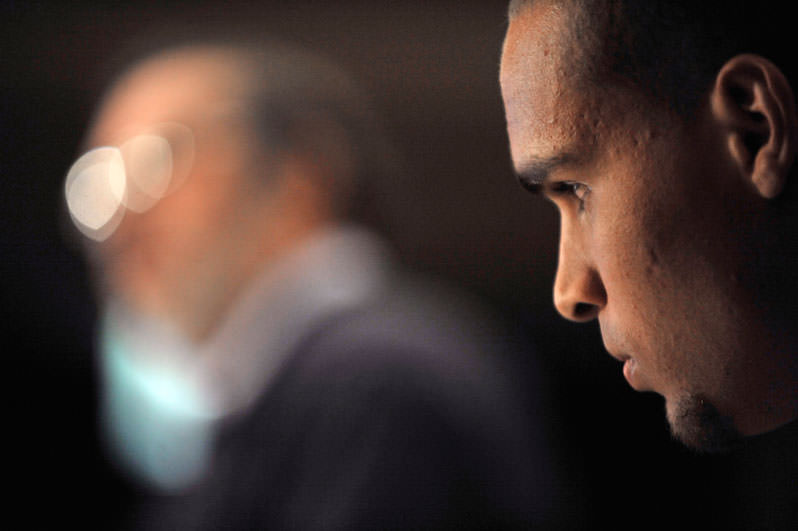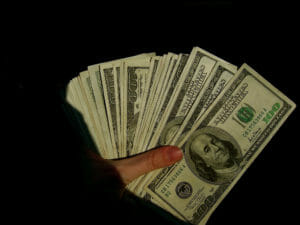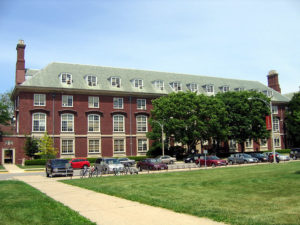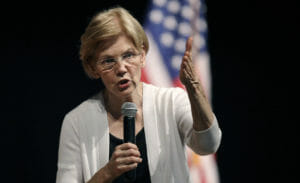Why Not End College Athletics Altogether?
An effort to form a players union in college isn't about money -- yet Nevertheless, it’s naive to think that giving the athletes a tiny percentage of the proceeds will clean up so corrupt a systemAn effort to form a players union in college isn't about money—yet. Northwestern University quarterback Kain Colter listens as United Steelworkers union President Leo Gerard speaks during a news conference in Chicago. Calling the NCAA a "dictatorship," a group of Northwestern football players announced they are seeking to form the first labor union for college athletes -- one they hope will eventually represent players nationwide. (AP Photo/Paul Beaty)
Northwestern University quarterback Kain Colter listens as United Steelworkers union President Leo Gerard speaks during a news conference in Chicago. Calling the NCAA a "dictatorship," a group of Northwestern football players announced they are seeking to form the first labor union for college athletes -- one they hope will eventually represent players nationwide. (AP Photo/Paul Beaty)
As quarterback Johnny Manziel said, “Don’t mourn, organize.”
Oh, wait, that was Joe Hill before his execution in 1915 when union organizing could mean putting your life on the line.
Of course, on the Joe Hill standard, none of us had better utter a peep about anything. That was then. This is now, when the report that college athletes are trying to unionize is merely the latest chapter in an ongoing discussion.
In fact, Northwestern University quarterback Kain Colter, who helped form the College Athletes Players Association that is asking for certification from the National Labor Relations Board, represents a hard-pressed, if not oppressed, minority toiling at the mercy of taskmaster coaches who take up five hours of their day on practices, film sessions, et al., and can jerk their scholarships away on a whim.
Nevertheless, Colter’s announcement of the petition to seek union representation does not mean what it was taken to mean — an attempt to get college athletes paid, which players aren’t seeking … at the moment.
In many minds, the ideas are twins. ESPN ran a poll with its report, asking the audience what it thought of college athletes organizing, which was in the story, and seeking payment, which wasn’t.
In fact, the long, ongoing discussion has been about paying college athletes, not the workplace conditions which, to date, are all that Colter has cited. The National College Players Association, with which Colter has been working, lists 11 demands on its website. Chief among them is “Minimize college athletes’ brain trauma risks.”
The pay-the-athletes debate has gone on for so long, there’s growing support on levels as lofty as the article in The Atlantic by historian and author Taylor Branch, headlined “The Shame of College Sports.”
To be sure, college athletics are shot through with shame, a wildly successful for-profit endeavor covered by a too-small fig leaf of amateur regulations.
Nevertheless, it’s naive to think that giving the athletes a tiny percentage of the proceeds will clean up so corrupt a system.
Advocates of paying the athletes are motivated by the incessant “scandals,” including the penny-ante ones like buying someone an illegal meal, which is the way schools like to portray the problem.
No one likes to think of the real scandals. Fortunately, they don’t have to because they’re all but impossible to uncover without subpoena power (a problem for the NCAA’s toothless enforcement office as well as the press).
You know, when University of Kentucky assistant coach Dwane Casey shipped $1,000 to basketball player Chris Mills’ father, and the parents of USC’s Reggie Bush got a rent-free home?
Those were reported because an Emery Air Freight envelope addressed to Mills’ father split open, and an agent who had been nosed out of representing Bush blew the whistle. If you’re around college athletics, all you hear are stories like that, which rarely get out.
(Actually, there were repercussions when the Emery envelope split, revealing $1,000 in $20 bills. Casey sued Emery, which settled.)
A $2,000 monthly stipend, as once proposed by the NCAA, would hardly stop six-figure payoffs to star athletes whose recruitment means millions in direct revenue, not to mention donations, amid stories of briefcases filled with cash and $180,000 signing bonuses (what the father of Auburn University quarterback Cam Newton allegedly sought through a middleman).
Personally, I don’t think paying the athletes would even clean up the penny-ante abuses, given the alumni’s urge to fawn over them.
Oh, and it’s philosophically indefensible if they don’t divide the proceeds among athletes in non-revenue as well as revenue-generating sports, not to mention everyone else who contributes time and effort to represent the school like the marching band and the cheerleaders. The College Athletes Players Association is at the other extreme, open only to Division I football and basketball players.
The association is pressing for better workplace conditions — an issue wherever football is played, suggested by all the contortions the NFL is now putting itself through after years of being sued by former players — and seeking to have scholarships extended to cover the full cost of attendance.”This is about finally giving college athletes a seat at the table,” Ramogi Huma, a former UCLA linebacker and president of the National College Players Association, told ESPN’s Tom Farrey. “Athletes deserve an equal voice when it comes to their physical, academic and financial protections.”
Hey, why not? Huma says the College Athletes Players Association is not asking that players receive salaries, but declined to rule out the possibility that it might in the future. In fact, in 2011, Huma’s three-point plan for paying college athletes was published by The Atlantic.
Included was changing the notion of “amateur” to the anything-goes standard of the Olympics — which lets NBA players and professional tennis stars compete — allowing college athletes to make money on their own, doing things like signing memorabilia. This, of course, would be a bonanza for Manziel, who was suspended — for the first half of Texas A&M’s opener — for violating NCAA rules against accepting thousands of dollars for signing merchandise.
Not that Johnny Football (as Manziel is known) would have to sign anything else. In Huma’s system, he could have a $100,000-a-year deal with Nike.
Most of what I now believe about who is owed what in a collegiate setting comes from a discussion a couple of years ago with students in Truthdig Editor-in-Chief Robert Scheer’s Media and Society class at USC.
With several Trojan football players in the class, I asked what time demands they faced. Four to five hours a day, came the answer, between practices, treatment and meetings.
Introducing me to today’s reality, another student, who wasn’t an athlete, said four or five hours’ work a day for a full ride at the $46,000-per-year-in-tuition school sounded like a good deal to him, compared with borrowing enough to attend and graduating owing $100,000 or more. (Hopefully, he will then find work, which wasn’t an issue for liberal arts students in the ’60s when I majored in history, but is today.)
As far as the ills of college athletics, it’s an absurd system with rights, or the lack thereof, grandfathered in. If labor is valuable but free, corruption is as inevitable as breathing, but the people who own the golden goose won’t let anyone else touch a feather on its head.
Slimy or not, college athletics “work” because there’s a huge audience for them. We have them because enough of us want them.
College athletics aren’t inevitable. They don’t have them in Europe, where aspiring athletes attend sports academies and turn pro when they’re good enough (a good way to cut down on the millions of prep and college varsity athletes aspiring to become professionals, of which only a handful will). Schools are for people who want to study there.
I know, it doesn’t seem as much fun as we have in the bowl season or March Madness, but it seems to work for them.
Your support matters…Independent journalism is under threat and overshadowed by heavily funded mainstream media.
You can help level the playing field. Become a member.
Your tax-deductible contribution keeps us digging beneath the headlines to give you thought-provoking, investigative reporting and analysis that unearths what's really happening- without compromise.
Give today to support our courageous, independent journalists.




You need to be a supporter to comment.
There are currently no responses to this article.
Be the first to respond.